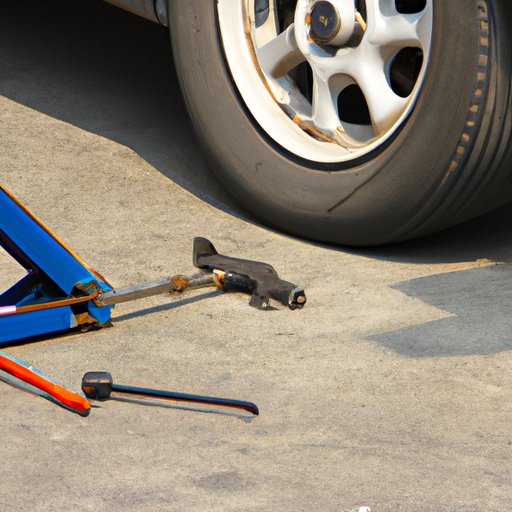
I. Introduction
Having a flat tire while driving can be a frightening and stressful experience, especially for new drivers. It’s important to know how to change a tire yourself in order to avoid having to wait for roadside assistance or risking your safety by attempting to drive on a flat tire. This guide will provide a step-by-step process for changing a tire, with helpful tips and advice for people of all experience levels.
II. Step-by-Step Guide
The first step in changing a tire is to ensure that you are in a safe location, away from traffic and on level ground. Make sure your emergency brake is engaged and your hazard lights are on to signal to other drivers. Next, locate your spare tire and make sure it’s properly inflated. Then, use a lug wrench to loosen the lug nuts on the tire you need to replace. Once the lug nuts are loose, use a jack to lift the car off the ground and carefully remove the tire. Finally, mount the spare tire onto the car, tighten the lug nuts, and lower the car back to the ground.
It’s important to note that not all cars are the same, so it’s important to consult your vehicle’s owner’s manual for specific instructions and recommendations. Additionally, if you are uncomfortable or unsure about any part of the process, do not attempt to change the tire yourself and instead seek the help of a professional.
III. Video Tutorial
While written instructions can be helpful, many people learn better by watching someone else complete the task. That’s why we recommend checking out this informative video tutorial that demonstrates the process of changing a tire in real-time. This tutorial offers a visual aid to accompany the written instructions above, making it easier for visual learners to wrap their heads around the task.
IV. Common Mistakes to Avoid
While changing a tire is a relatively straightforward process, there are some common mistakes that people often make. These include using the wrong tools, not properly securing the vehicle, and not properly tightening the lug nuts. One major mistake to avoid is attempting to change a tire on an uneven surface as this can cause the car to tip over. Always ensure that you are on level ground before beginning the process.
V. Tools of the Trade
Before you can change a tire, you need to have the right tools on hand. These include a lug wrench, jack, and spare tire. It’s important to make sure that these tools are in good working order and that you know how to use them properly. For example, you’ll need to know the appropriate jacking points for your specific vehicle as well as the right amount of torque to use when tightening the lug nuts.
VI. Troubleshooting
Even if you follow all of the steps correctly, sometimes things can go wrong during the tire-changing process. For example, a stubborn lug nut may not come loose, or your spare tire may be flat. In these cases, it’s important not to panic. Instead, try using a lubricant such as WD-40 to loosen the lug nut or use a tire sealant to inflate the spare tire. If you’re still stuck, don’t hesitate to call for roadside assistance.
VII. Safety Precautions
Changing a tire can be dangerous if you don’t take the proper safety precautions. Always make sure that you are in a safe location away from traffic and that your hazard lights are on. When using a jack, make sure that it’s on solid ground and that the car is stable before going under it. Never get under a car that is only supported by a jack. Wear protective gear, including gloves and eye protection, and use caution when working near traffic.
VIII. Conclusion
Knowing how to change a tire is an important skill for any driver. By following the step-by-step process outlined above, you can ensure that you are able to change a tire safely and effectively. Remember to consult your vehicle’s owner’s manual for specific instructions and recommendations, and to seek the help of a professional if you are unsure or uncomfortable with any part of the process. By staying safe and being prepared, you can avoid being stranded on the side of the road with a flat tire.




